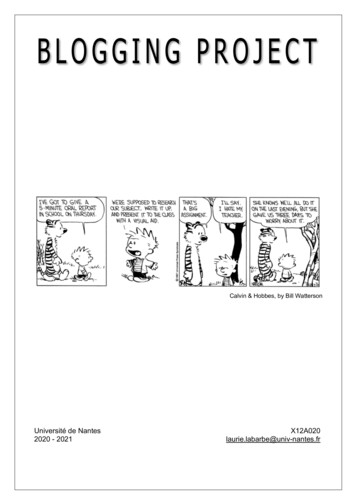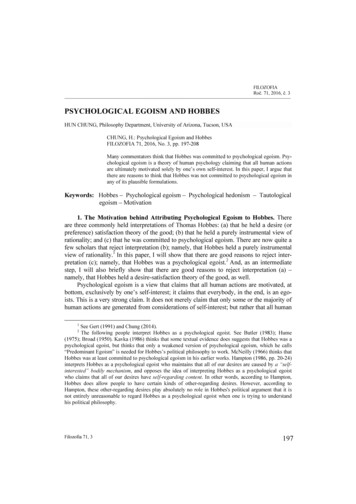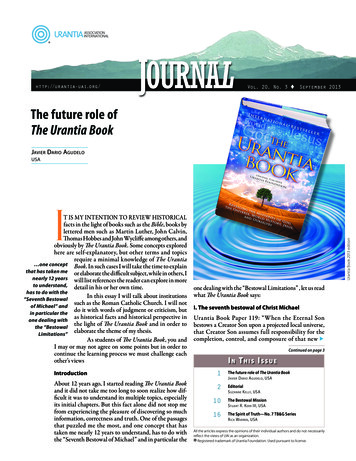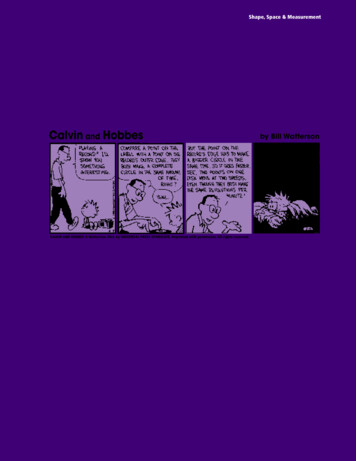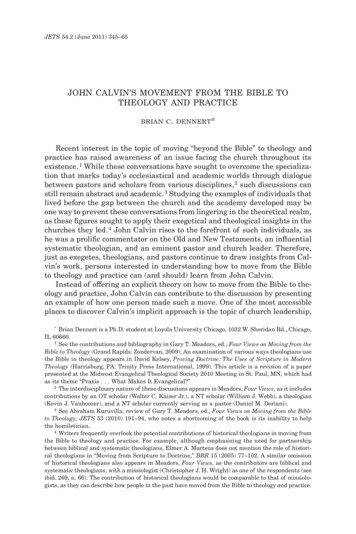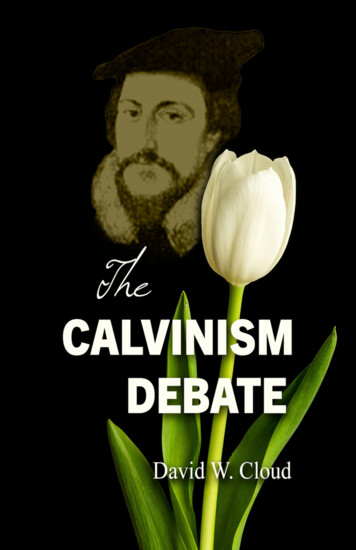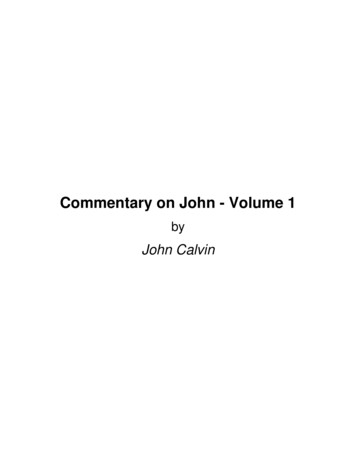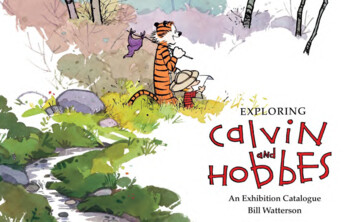
Transcription
U- i'EXPLORINGC4\viNHo'pt.BAn Exhibition CatalogueBill Watterson
EXPLORINGCOh'N«nJHOPES’
EXPLORINGCOh'iNHOPES’An Exhibition CatalogueBill Watterson and Jenny RobbuAndrews McMeelPublishing*i Library & Museu
CONTENTSPrefaceJenny Robb Interviews Bill WattersonINFLUENCESEARLY WORKGETTING GSOCIAL COMMENTARYTHE MEANING OF LIFECOLORSUNDAYS
PREFACEBILL WATTERSON'S Calvin and Hobbes had it all: humor, heart, andwisdom wrapped up in a beautiful package of sophisticated and livelygraphic storytelling. From 1985 to 1995, the strip delighted millions ofnewspaper readers around the world. Even after Watterson ended the strip,new generations continued to discover it in book collections or online.Exploring Calvin and Hobbes encourages fans to revisit the strip in a newcontext and setting in the hopes that it will result in fresh insights into thewildly popular strip and its creator.The Billy Ireland Cartoon Library & Museum is honored to house theBill Watterson Collection of more than 3,000 original Calvin and Hobbes comicstrips and related materials. Watterson placed the collection here in 2005,ten years after ending his acclaimed and much-beloved comic strip. TheLibrary's mission is to preserve materials related to cartoons and comics,and to make them accessible to researchers and fans of the art form to studyand appreciate. The Library contains more than 100,000 books, magazines,journals, and comic books; more than 300,000 original cartoons; and more
than 2 million comic strip clippings and newspaperpages. In addition, it houses the archives of a wide varietyof cartoonists, industry professionals, syndicates, andprofessional cartoonists' organizations. The Library'sdiverse and ever-growing holdings allow collectionslike Watterson's to be examined and understood in thecontext of the entire history of cartoon and comics art.This is only the second solo exhibition ofWatterson's work. The first, Calvin and Hobbes SundayPages: 1985-1995, was organized by Lucy SheltonCaswell and featured original Sunday strips chosen byWatterson. It was on display from September 10, 2001,to January 15, 2002, in the reading room of the BillyIreland Cartoon Library & Museum, which was thencalled the Cartoon Research Library. The exhibition alsotraveled to the Cartoon Art Museum in San Francisco,where I was fortunate enough to be serving as curatorat the time and where the exhibition was on displayfrom February 16 to April 14,2002.In 2011, construction started on a new facility forthe Billy Ireland Cartoon Library & Museum, with plansto include a museum with three exhibition galleries. Theexpanded facility provided the perfect opportunity toorganize a larger and more comprehensive exhibitionof Watterson's work. It also seemed like an ideal timeto revisit and reexamine the strip and its place in themedium's history. When Caswell organized the firstexhibition in 2001, Watterson didn't feel that enough timehad passed to consider the exhibition a retrospective.Although we didn't use the word "retrospective" inthe title, this exhibition and the extended interviewin this catalog are intended to serve as a retrospectiveexploration of the strip and Watterson's journey as anartist from his early efforts as a student until he endedCalvin and Hobbes in 1995.The exhibition also gives viewers a rareopportunity to see Watterson's expressive brushstrokesand masterful watercolors in their original form.Examining his drawings and paintings reveals insightsinto his process that are not discernible while viewingreproductions of his work. Although the work wasoriginally intended to be seen in printed form, there
are wonderful subtleties—from his light pencils andoccasional use of white-out to the variety of wayshe approached coloring his art for book covers andillustrations—that are discoverable only throughexperiencing the original art.For this exhibition, Watterson was interested in amore independent and objective review of his work, sohe did not choose the specific strips to include. I wasthrilled to make the selections, although it turned outto be a rather daunting task. In the first place, it's rarethat we have such a complete collection of a cartoonist'swork from which to choose. Second, the strip's qualitywas consistently high throughout its run. Both are verygood situations to have when curating an exhibit, butthey did make it difficult to whittle down the list to amanageable number that would fit in the gallery. Myfirst pass resulted in more than twice as much work aswe could show. It was painful to cut some of my personalfavorites, but in the end, I hope the exhibition provides arepresentative selection that will appeal to a wide rangeof visitors, from the superfans who know every strip byheart, to those who are discovering the strip for the firsttime or rediscovering it after many years.Watterson was actively involved in many otheraspects of curating the exhibition and could not havebeen more generous withhis time and ideas. Together wediscussed the exhibition's themes, structure, and design.He chose the cartoonists included in the "Influences"section and wrote the labels describing the impact eachhad on his work. He also wrote descriptions of thetools he used to create Calvin and Hobbes. Finally, I amespecially grateful to him for agreeing to sit down withme at the Library to discuss his life and career.Exhibitions are always a team effort, and Ihad the good fortune to work with some wonderfulpeople to make this one a reality. First and foremost,special thanks go to Lucy Shelton Caswell and RichardWest, who were instrumental in initially bringingthe collection to the Billy Ireland Cartoon Library &Museum and without whom this exhibition wouldnot have been possible. The amazing staff of the BillyIreland Cartoon Library & Museum including Susan
Liberator, Caitlin McGurk, Wendy Pflug, Marilyn Scott,and Juli Slemmons all contributed their time and talentsin important ways. I would also like to recognize theUniversity Libraries exhibits team of Erin Fletcher,Justin Luna, Jeremy Stone, Harry Campbell, and PamMcClung for all their help with organizing, designing,and installing the exhibition. Steve Hamaker providedinvaluable design assistance and was responsible for thefantastic design decals in the exhibition. Many thanksgo to the wonderful and patient people at AndrewsMcMeel Publishing, including Dorothy O'Brien and JoeWormington. Finally, I am grateful to Carol Diedrichs,vice provost and director of University Libraries, andLisa Carter, associate director for special collectionsand area studies, for their support of the Billy IrelandCartoon Library & Museum and its distinctive collections.Jenny E. RobbCurator and associate professorBilly Ireland Cartoon Library & Museum,The Ohio State University
JENNY ROBB INTERVIEWSBILL WATTERSONBilly Ireland Cartoon Library & Museum, The Ohio State UniversityJR: It's been a pleasure working with you on the exhibit Exploring Calvin andHobbes, and I’m delighted to have this opportunity to sit down with youto ask you some questions about your life, your career, and comics. To getstarted, can you describe what it was like to grow up in northeast Ohio?BW: I grew up in Chagrin Falls, which is a small town, an outer suburb ofCleveland. It was originally a mill town in the 1800s, and a paper-bagfactory was still going when I was growing up. They used to dumptheir dyes right in the river, so as a kid I remember seeing the riverturn red and so on, if you can believe it. The town is fairly upscalenow, but back then maybe a little less so. There was a hobby shop, astationery store, three little drugstores, two hardware stores, and soon. Small local businesses where you could get pretty much anything
you'd need without driving somewhere else. TheMain Street bridge goes over a big natural waterfall,and Victorian buildings surround the town triangle,which has a bandstand in the middle of it. It's oneof these quintessentially American towns that dotOhio. Very Norman Rockwell—all white, veryRepublican. I had a sheltered childhood.Our house was on a one-acre lot, at the outskirtsof the village, with a big woods behind us. We didn'town the woods, but it extended all the way to the river,and you couldn't see an end to it. Our yard droppedcontinuously from the back door to the woods, soit was a truly fabulous sledding hill. There were ahandful of neighbor kids about my age, so we messedaround unsupervised in a way that kids don't seemto do anymore. Many of our mothers were home, sothey'd just turn us loose and nobody worried.Sometimes in the strip I tried to illustrate thosebig empty summer days spent messing around. Itseems very anachronistic now that kids' lives areorganized to the minute.JR: My husband and I are looking at houses, and wheneverwe see one with a woods, we call it a Calvin and Hobbesbackyard.BW: To be honest, we didn't tramp around the woodsall that much. Because it was low and headingtoward the river, it was somewhat marshy andbrambly. You'd get stuck full of prickers or tangledin brush, with your feet starting to sink into muck.We'd venture in occasionally, but it's not like I wasChristopher Robin.But I loved having that much nature aroundus. It mitigated the suburban feel, which I imagineis why my parents chose the property. Havingsomething a bit wild and mysterious and beautifulat the end of the yard was a memorable thing.Now it's a subdivision, of course. Looking ata cul-de-sac of McMansions doesn't have the sameimpact on the imagination. We like to think their
JR: So what were you like as a child?BW: Everybody else was really weird, but I wascompletely normal, (laughter) I was generally aquiet kid. I lived in my head like Calvin, but Iwas the opposite of Calvin in terms of courtingexcitement and risk. It wasn't hard for me to meetthe expectations of grown-ups, and I quicklyfigured out that if you did that, they left you aloneand you could do what you wanted. So that waseasy. It was negotiating the snake pit of schoolkidsthat I found difficult. My home and the slightlyolder kids in my neighborhood were a refuge.I loved to draw, of course. When I wasabout Calvin's age, I was very interested inbirds and dinosaurs, and I liked to draw them.I say I was interested in them, but I don't knowthat I actually read or learned anything aboutthem. I just thought they were cool to look at,and I got so I could identify and draw all sortsof them. My interests were quite fanatical intheir way—and at the same time, incrediblysuperficial!JR: Your parents were encouraging?BW: Yes, very encouraging, very supportive. My momwas basically my audience until I went to college,and my dad often introduced me to art supplies.He could draw pretty well, although he never hadmuch time for it until later. When I was doing thestrip, we'd go out and paint together on visits.I think my dad was the one who told mePogo was probably drawn with a brush. I triedcopying Pogo characters—this was maybe in highschool—but a brush line is hard to control at best,and because my brush was too large,—probablya watercolor brush,—I couldn't do it. It was veryfrustrating, so I went back to pen, and it wasn'tuntil college that I gradually figured out you canget tiny brushes that will make a thin line, and Iworked on developing the necessary touch. There
was never any information back then, but I alwayshad materials to play with.Really, I suppose the biggest gift my parentsgave me was a lot of time. There was never a sensethat I should be doing something else. If I was up inmy room drawing, nobody bothered me. That kindof time is just indispensable. It's not a luxury, it's anabsolute requirement. You've got to mess around—it's the only way to figure stuff out.It's hard to reconstruct this accurately,though. My memory is that I spent hours and hoursdrawing, but it may have been fifteen or twentyminutes, who knows. A kid's idea of a long time is notreliable information. But I drew comics from a veryearly age. It was the only kind of art I understood,and it connected immediately. The simplicity of thedrawings was like a big welcome mat. My wholechildhood was about cartoons. I just loved them.JR: To elaborate a bit, how exactly did you learn to drawcartoons? You mentioned copying Pogo. Did you everhave any classes or formal art training? Or training incartooning?BW: No. There were no classes in cartooning then.Cartooning was what you did to avoid classes!And it's funny: although I'm certainly gladcartoons are finally getting some respect as anart. I'm fairly ambivalent to see cartooning as alegitimate academic offering. If comics need to bedeconstructed and explained, something is reallywrong with them.I found a Pogo book in fifth grade, at a librarybook sale. I picked it up, thinking my dad mightlike it, but I ended up keeping it. My parents hadliked Peanuts and Pogo around their college yearsin the mid-'50s. Those strips were a little bit edgyfor the time, more intellectual, new and different. Ithink the first Peanuts books I read were just lyingaround in the house. But for years afterward, Iasked for Peanuts books for Christmas and birthdaypresents, and I eventually amassed all the old Holt
Rinehart books. Each book was a dollar, and Iremember the agony of deciding which one to buywith my own money.I had that Pogo book for a while before I readit. The cartoons were so dense and black, with athousand words in every strip. It was a visuallyoppressive thing to look at when you've grown upon Peanuts. And I think the newspaper comics pageshad already pretty much changed by this point.There were still some continuity strips hanging inthere that had a lot of black, but most of the gagstrips that I liked had followed the Peanuts pathtoward simplicity and white space, especially as thecomics began shrinking. So it took me a couple ofyears before I sat down to seriously read Pogo, and Idon't know what I made of it at first, but the lovelydrawings pulled me along until I grew to love thewhole strip. All this was late middle school.Peanuts was there from the beginning, though.I had no idea what a weird, strange strip Peanutswas. Being a kid, I just took it at face value. Theexpressiveness of Charlie Brown's misery connected,but it was Snoopy and the more fantastic, silly stuff,that really grabbed me.JR: The Red Baron strips?BW: Right, the Red Baron strips, definitely. Thosedrawings are just lovely. Snoopy wearing goggles,sitting on his doghouse, gritting huge teeth—the premise and the execution are both insane. Iadmired them to no end. I still do.There was a great serendipity with Peanuts.The strip became this pop culture tsunami justat the time I got into it. The licensing was justramping up and Peanuts was everywhere. I lovedgetting each new book, and I was thrilled when theChristmas and Halloween TV specials came out.It all happened right when I was most receptiveto it. Peanuts was one big, long cartooning classfor me—even the writing, which I wasn't aware Iwas absorbing. The length and pace of a story, how
to create suspense—I soaked up all those thingsjust from reading it so much. And over time, themachinery of comic strips became second nature asI started drawing my own comics.My earliest comics were not very involved.I'd just fold a sheet of notebook paper into eightsquares and try to get something that passed for apunchline at the end.In middle school, I started drawing with acartridge pen. My sixth-grade teacher—rightly, butrather peculiarly—hated ballpoint pens, and shemade us write all our papers with a cartridge pen,with real ink. I'm sure we were the only twentyeight kids in America using real ink pens at thattime, but I thought they were absolutely great. It's abeautiful, flowing way to write. So I started using
that for cartoons, and I often drew my cartoonsin blue. I never penciled anything—who's got thatkind of time? I just drew with the pen. By then,I was coming up with some little characters andtrying to write jokes and situations for them. I'dbang one out and see if I could get my brother ormy mom to laugh.JR: Did you read any comic books growing up ?BW: Some, but nothing made a big impression. I readsome Batman comic books when the '60s BatmanTV show came out. It was good cheesy fun, but justsort of a diversion, nothing I cared much about.A little later, through much of my teens.Mad Magazine was a big deal for me. I liked DonMartin, Sergio Aragones, Mort Drucker, and someof the others, although today I don't look back onthe magazine with any real affection. You know,it's great when you're eleven. But if it had been abetter magazine, a little deeper, you could rereadit at age fifteen or twenty and get more out of it.But you can't—it's just humor for eleven-year-olds.And they're willing to lose their audience at agefifteen, because there's a new crop of eleven-yearolds every year. They don't need to reach any higher,and that just seems lazy to me. Mad's irreverenceseemed revolutionary at the time, but now I thinkit was mostly cynical—a snotty-kid attitude—notreally based on any moral outrage. They ridiculedthings not because they truly objected to them,but because those things were popular, and theywanted to ride that wave. So this magazine thatI thought was wild and rebellious at age elevennow just seems sort of easy and dumb.We should probably edit that out. (laughter)JR: Growing up, Mad didn't resonate with me the way itdid with some of my peers, but I don't think I was theirprimary audience. Not that it was entirely a gender thing,but I knew more guys who read it.
BW: Right, I think it was sort of a boys' club. There areplenty of cartoonists who get dewy-eyed thinkingabout Mad all these years later, but I'm not one ofthem. There was a period in the '50s when it wasenergetic, but by the time I was reading it in themid-'60s, it was very formulaic. Even as a kid, I waspuzzled by the fact that, after a movie satire by MortDrucker, they'd have a TV satire by a Mort Druckerimitator. They turned Drucker into a house style forcaricature! That sort of thing galls me now, but evenas a kid, it seemed odd and vaguely disappointing.JR: Was your family religious at all, growing up?BW: No. To be honest. I'm glad I got to figure out what Ithink about those issues on my own, without havingto fight somebody else's dogma to get there. So Iwas happy enough to avoid churches, but when Igot to college, I had occasion to discover what a holethat left in my education. I took a general art historyclass, and of course, so much of art was religiouspainting, and I was just lost. I didn't know the Biblestories, who the people were, what they meant, oranything. I didn't get a lot out of certain classes.So, on the assumption that you're leading up towhy I named my central character after a sixteenthcentury theologian . well, it was a joke, (laughter)Mostly on me.JR: What did you study in college, and how do you thinkyour studies might have informed Calvin and Hobbes ?BW: I went to Kenyon College, which is a small liberalarts school in central Ohio. Very pretty campuson a hill overlooking cornfields. It's known for theKenyon Review, not that I've ever read it. English hadbeen one of my favorite classes in high school, so Ithought that might be what I'd study. I took a lot ofEnglish classes at Kenyon, but much of the readingmade my eyes glaze over, and for rather misguidedreasons, I ended up majoring in political science.
The importance of Kenyon to my cartooningwas more personal than academic, because withindays of arriving, I saw that the school paper hadbeen printing these astonishingly professional looking political cartoons by Jim Borgman, who,very conveniently for me, had just graduated.Borgman had been hired by his hometownpaper, the Cincinnati Enquirer, immediately upongraduation, and the fact that he had somehowcracked the code to becoming a professionalcartoonist was incredible to me.When I was in high school, I had drawn ahandful of political cartoons for the local suburbanpaper. My town had gotten some new police carsthat were very fancy, so my mom talked me intosubmitting a drawing of a souped-up police carwith all sorts of bells, whistles, and foghorns ontop. To my great surprise, the paper not onlyprinted it, but they enlarged it, so it was giganticon the editorial page. Being seventeen or whatever,this made my head pretty gigantic too. I occasionallysubmitted some other cartoons, and gradually thisbecame a sort of freelance summer job.So anyway, I get to Kenyon and see thatBorgman had great success doing politicalcartoons, so I decided to continue in that directionand do political cartoons myself. I'm sure that ifI had presented the paper with a strip or single panel cartoon, that would've been absolutely fine,so this line of thinking was a bit screwy on mypart, but it seemed Jim had paved a big wide roadthat evidently led to prestigious employment, so Ifigured I'd put my car on that road.Seeing my interest, someone on the schoolpaper told me, "You need to talk to Rich West."Rich was a junior that year, and had been a friendof Borgman's, so I introduced myself and we hit itoff. Rich had a deep interest in history and earlyAmerican political cartoons, and I don't think hecould believe his luck to come across two seriouscartoonists at this out-of-the-way college, so heencouraged me endlessly. In short, the minute I set
foot on campus, I made two personal connectionsthat were extremely formative for my cartooningAnd then, with political cartooning in mind,I started steering my academic work toward thisgoal, because I literally knew nothing. It would behard to exaggerate how backward and ill-informedI was.JR: You mean about politics.BW: About everything, but especially politics! I guess it'sa testament to the power of self-absorption, but allthe conflict of the '60s might as well have happenedon Neptune as far as I was concerned. I was a bityounger than the Woodstock generation, and nothaving a personal stake in the social upheaval, Ihad the luxury of being pretty oblivious. Vietnamand Watergate were over by the time I got to college.I learned a little bit over the years at college,but needless to say, political cartoons were alwaysterrifically difficult for me, since the subject matterwas not any sort of genuine passion. Looking back,I can see it was the totally wrong direction forme all along, but at the time, who knew? MaybeI could figure it out with a little more work. Iwas dogged—that's all that got me through. If acartoon got drawn, it was through sheer force ofwill. I didn't have any knowledge, I didn't have anystrong beliefs or opinions. the only parti actuallycared about was the cartooning. All the rest wasjust what I had to do to get to the cartooning part.It was nuts, but that's what I did for four years.JR: Were you paying attention to specific political cartoonistsat the time?BW: Yes, and that was fun. Previously, my pool ofinfluences was pretty small—mostly the few comicstrips I liked. Pat Oliphant's work became veryimportant to me, although I'd actually known ofhis work even as a kid. Jeff MacNelly was a big
deal in the Carter years, when I was in college.MacNelly had a lighter, more jokey take on events,with wonderful, elaborate drawings of trains andmachinery and things. I think Oliphant holds up alot better—more venom and variety in his work—but MacNelly's artwork influenced virtuallyeverybody working then. I got Mike Peters's earlybooks of political cartoons, and those were fun.Again, a pretty silly sense of humor, and there wasa craziness to the drawing that was a thrill. Hiswildly exaggerated caricatures were a big surprise.And Borgman, of course. He'd mail me batches ofhis work with a letter periodically, and that wassuch a boost and inspiration. I marveled at hisvisual inventiveness.Editorial cartoons typically had more spaceto work with than comics, and a lot more visualcomplexity than I was used to, and it was a bit scaryto discover the limits of my drawing skills when Itried to do a more involved picture. I couldn't drawnearly as well as I thought I could.At the very beginning of freshman year, theart department had an orientation meeting, wherethey explained how the program worked. Everyonewas required to take an intro drawing class, andafter the meeting I went up to the drawing teacher,Martin Garhart, and asked if I really had to start atthe beginning, since I was pretty hot stuff with apencil and could be moving along if they'd get outof my way. (laughter) He gave me this cold look andsaid, "I think I can teach you something." So I tookDrawing 101, and man, he taught me a lot\ (laughter)Yeah, it was sad. My skills were pretty thin.JR: You liked the class?BW: It was quite challenging. Garhart taught Borgmantoo. A great teacher, very interested in narrativeart. He was a printmaker at that time, but he's sincegone into painting. Yeah, he knocked my head intothe wall.
JR: Did you take other art classes beyond that?BW: I allowed myself one full credit of art every year.I look back at Kenyon as an ocean of missedopportunities and misdirected efforts. I should'vegone to college when I was thirty-five. My parentsnever tried to steer me at all, but I would've feltirresponsible taking a lot of art when they werepaying that much money for my education. I figuredI could learn art on my own, and might preferto anyway. But over the years I took classes indrawing, life drawing, and printmaking. I had somevery good teachers and got a lot out of them all.I never took any painting. I knew they'd beteaching us about color, and the idea of sittingthere mixing colors seemed soooo tedious. So Iskipped that, and had to figure it all out the hardway twenty years later. For senior year, I took aself-directed, make-whatever-kind-of-work-youwant class. I didn't have enough inner resourcesto know what to do with that, so I sort of coastedthrough and never pulled it together. It waswasted on me. Fortunately, I wasn't an art major.It's funny—I'm sure the teachers would havebeen receptive if I'd done cartoons as a seniorproject, but I never wanted to mix cartooning withart classes. I guess I wanted to keep cartooningseparate and all my own. That may have been a bitpigheaded on my part, but I wanted to make myown mistakes and figure out my own solutions inmy own way. I'm pretty much the same way withpainting today—I've never taken painting classes.I guess at some point, the things you need to learnare things nobody else can teach you.JR: After college you worked briefly as an editorial cartoonistfor the Cincinnati Post, but the job was not a good fit.Why do you think you were more suited to drawing acomic strip than political cartoons?BW: Again, I was fairly self-deluded about doing politicalcartoons. I thought I could muscle my way through it.
I figured that time and effort would make it happen.But after the Post, when I finally went back to comics,it was like coming home. Comic strips were sort ofthe language I grew up speaking. I think I took thatfluency for granted and figured I could leverage it intoother fluencies. But political cartooning just wasn'tthe right outlet for my personality and interests.The Cincinnati Post was a disaster from alldirections. It was my first job and I was young andvery naive. I'd never lived in a city and I had nobusiness being on a newspaper of any real size. Ididn't know what I was doing and that was scary.I was hired on a six-month trial basis. Halfwaythrough, the editor told me I could leave then orstick out the agreed-upon time, but this wasn't goingto work. I had nowhere to go, so I stuck out the fullterm for the sake of paying my rent, but continuingto work after being fired just added another layerof lunacy to an already surreal situation.I'd worked for newspapers a lot, but never at anewspaper. I was used to drawing cartoons alone inmy room. Ninety percent of what a cartoonist doesis stare into space, so it's not something I generallycare to do with an audience. All of a sudden I'm in themiddle of a newsroom with a hundred other people,and it's chaos. They gave me a table by a blaringpolice scanner. It was pandemonium all around meas I sat at my desk, open-mouthed and blinking.I had to take my roughs to the editorial pageeditor for approval. She rarely okayed anything butif she thought my sketch was potentially acceptable,she'd send it over to the main editor, whereuponhe'd pass it back saying it was no good. So I'd comeup with another idea, and he might like it and shemight not, so he'd reevaluate and decide shewas right—it was no good. So I'd come up withanother idea and neither of them would like it. Inthis manner, I might get one cartoon published ina week of sitting there banging out roughs, and Ifelt like a total fraud.All the more so because the pay was prettynice. I was actually on the editorial staff. In 1980,
George Bush Sr. was on the ticket with Reagan, andsuddenly the word went through the newsroomthat Bush was coming up to talk to the editors.Being in the editorial department, I was invited.So I'm twenty-one, an impostor at my job, sittingin the editor's office with all these middle-agededitors and seasoned reporters, and I'm doodlingpictures of George Bush while he's sitting a fewfeet away. You know, absolutely every aspect ofthis scene was just plain wrong. So when I gotfired, I was crushed and mortified—but there wasno sense of injustice! (laughter)1 sent out submissions to other papers foranother year, but couldn't get a bite. Having nothingto lose, I went back to comic strips and there wasan almost palpable sense of relief. You don't needto know anything—you just make stuff up!JR: Well, it's a great example of failure turning intospectacular success, but it's hard sometimes to see thatwhile you're involved in the failure.BW: True, although there were a number of years out inthe w
BILL WATTERSON'S Calvin and Hobbes had it all: humor, heart, and wisdom wrapped up in a beautiful package of sophisticated and lively graphic storytelling. From 1985 to 1995, the strip delighted millions of newspaperreaders aroundthe world. Evenafter Watterson ended the strip, new generation
